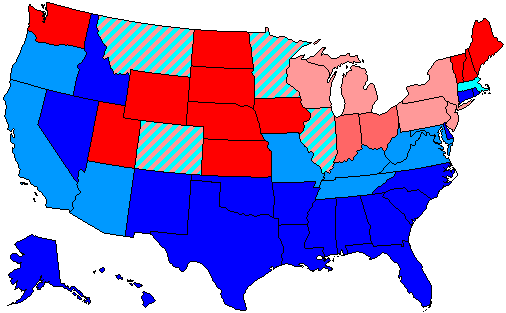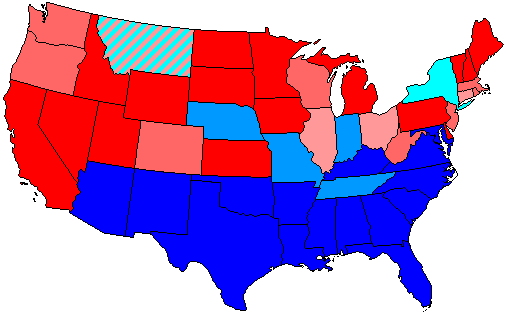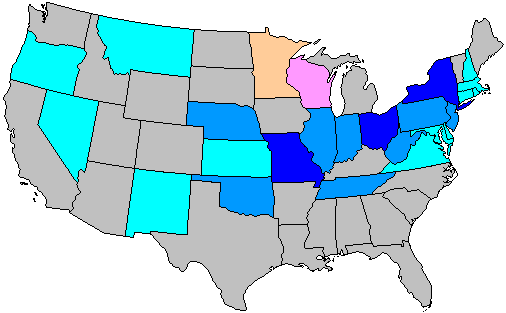|
North Dakota's 1st Congressional District
North Dakota's 1st congressional district is an obsolete congressional district in the state of North Dakota that existed from 1913 to 1933, and from 1963 to 1973. History Prior to 1913, North Dakota elected two members of the United States House of Representatives at-large. Following the 1910 Census, reapportionment gave North Dakota another seat and beginning with the 1912 congressional elections, North Dakota divided its delegation into three districts. Following the 1930 Census The United States census of 1930, conducted by the Census Bureau one month from April 1, 1930, determined the resident population of the United States to be 122,775,046, an increase of 13.7 percent over the 106,021,537 persons enumerated during ..., North Dakota lost a seat and returned to electing two members at-large in 1933. In 1963, the state divided into two congressional districts. Following the 1970 redistricting cycle after the 1970 United States census, North Dakota lost another seat, ... [...More Info...] [...Related Items...] OR: [Wikipedia] [Google] [Baidu] |
North Dakota
North Dakota () is a U.S. state in the Upper Midwest, named after the Native Americans in the United States, indigenous Dakota people, Dakota Sioux. North Dakota is bordered by the Canadian provinces of Saskatchewan and Manitoba to the north and by the U.S. states of Minnesota to the east, South Dakota to the south, and Montana to the west. It is believed to host the geographic center of North America, Rugby, North Dakota, Rugby, and is home to the tallest man-made structure in the Western Hemisphere, the KVLY-TV mast. North Dakota is the List of U.S. states and territories by area, 19th largest state, but with a population of less than 780,000 2020 United States census, as of 2020, it is the List of U.S. states and territories by population, 4th least populous and List of U.S. states by population density, 4th most sparsely populated. The capital is Bismarck, North Dakota, Bismarck while the largest city is Fargo, North Dakota, Fargo, which accounts for nearly a fifth of the s ... [...More Info...] [...Related Items...] OR: [Wikipedia] [Google] [Baidu] |
John Miller Baer
John Miller Baer (March 29, 1886 – February 18, 1970) was a U.S. Representative from North Dakota. Early years and education Born at Black Creek, Wisconsin, Baer was the son of Capt. John M. Baer and Libbie Riley Baer. His ancestors on the maternal side were the two families Riley and Swing. From the original family of the former descended the poet and humorist, James Whitcomb Riley, and from the latter, the philosopher and preacher. Prof. David Swing, of Chicago. Baer was also a descendant of the Blairs, an old and favorably known family of Southern Ohio. Baer attended the public schools of his town. He was graduated from Lawrence University, Appleton, Wisconsin, in 1909. Career He moved to Golden Valley County, North Dakota, in 1909 and engaged as a civil engineer and in agricultural pursuits from 1909–1915 and served as Postmaster of Beach, North Dakota. Baer also worked as a cartoonist and furnished cartoons and articles to newspapers. Baer worked for the ''Non-Parti ... [...More Info...] [...Related Items...] OR: [Wikipedia] [Google] [Baidu] |
1962 United States House Of Representatives Elections In North Dakota
The 1962 United States House of Representatives elections was an election for the United States House of Representatives in 1962, which occurred in the middle of President John F. Kennedy's term. As in most midterm elections, Kennedy's Democratic Party lost seats to the opposition Republican Party, but retained a majority. House Democrats were expected to lose their majority, but the resolution over the Cuban Missile Crisis just a few weeks prior led to a rebound in approval for the Democrats under President Kennedy. The number of seats up for election went back to 435, in accordance with reapportionment resulting from the 1960 census. The membership had been increased temporarily to 437 in 1959, providing 1 seat each for the new states of Alaska and Hawaii, while the other 435 seats continued with the reapportionment resulting from the 1950 census. This was the last midterm election cycle until 2022's in which a sitting Democratic president experienced net losses for his part ... [...More Info...] [...Related Items...] OR: [Wikipedia] [Google] [Baidu] |
Hjalmar Carl Nygaard
Hjalmar Carl Nygaard (March 24, 1906 – July 18, 1963) was an American politician. He represented North Dakota in the United States House of Representatives as a Republican from 1961 until his death in 1963. Background Nygaard was born on a farm near Sharon, Steele County, North Dakota. He was one of eight children born to Carl Nygaard and Anna Karene Grimson who had relocated from Decorah, Iowa. He attended the public schools of Sharon, Mayville State Teachers College and the University of North Dakota. Career Nygaard taught in the rural schools of Emmons and Steele counties from 1932 to 1935 and was engaged in the grocery and hardware businesses from 1936 to 1960. He served as mayor of Sharon and as a member of the school board and then as member of the North Dakota House of Representatives from 1949 to 1960. He served as majority leader of that body in 1955 and 1957 and as speaker in 1959. He was a member of the National Monument Commission from 1961 to 1963. On July 18, ... [...More Info...] [...Related Items...] OR: [Wikipedia] [Google] [Baidu] |
1930 United States House Of Representatives Elections In North Dakota
The 1930 United States House of Representatives elections was an election for the United States House of Representatives in 1930 which occurred in the middle of President Herbert Hoover's term. During the election cycle, the nation was entering its second year of the Great Depression, and Hoover was perceived as doing little to solve the crisis, with his personal popularity being very low. His Republican Party was initially applauded for instituting protectionist economic policies, which were intended to limit imports to stimulate the domestic market: however, after the passage of the heavily damaging Smoot-Hawley Tariff, a policy that was bitterly opposed by the Democratic Party, public opinion turned sharply against Republican policies, and the party bore the blame for the economic collapse. While the Democrats gained 52 seats in the 1930 midterm elections, Republicans retained a narrow one-seat majority of 218 seats after the polls closed versus the Democrats' 216 seats; ... [...More Info...] [...Related Items...] OR: [Wikipedia] [Google] [Baidu] |
1928 United States House Of Representatives Elections In North Dakota
The 1928 United States House of Representatives elections was an election for the United States House of Representatives in 1928 which coincided with the election of President Herbert Hoover. The strength of the U.S. economy resulted in Hoover's Republican Party victory in the election, helping them to scoop up 32 House seats, almost all from the opposition Democratic Party, thus increasing their majority. The big business-supported wing of the Republican Party continued to cement control. Republican gains proved even larger than anticipated during this election cycle, as an internal party feud over the Prohibition issue weakened Democratic standing. Losses of several rural, Protestant Democratic seats can be somewhat linked to anti-Catholic sentiments directed toward the party's presidential candidate, Al Smith. However, this would be the last time for 68 years that a Republican House was re-elected. Results summary SourceElection Statistics - Office of the Clerk S ... [...More Info...] [...Related Items...] OR: [Wikipedia] [Google] [Baidu] |
1926 United States House Of Representatives Elections In North Dakota
The 1926 United States House of Representatives elections was an election for the United States House of Representatives in 1926 which occurred in the middle of President Calvin Coolidge's second term. Coolidge's Republican Party lost seats to the opposition Democratic Party, but it retained a majority. The most pressing national matters at the time were fragmented, generally related to government's relationship to business or to providing social aid. However, no predominant issue was able to cast a shadow over the election. The small, populist Farmer–Labor Party also held two seats following the election. Overall results Source: Special elections Elections are listed by date and district. , - ! , John E. Raker , , Democratic , 1910 , , Incumbent died January 22, 1926.New member elected August 31, 1926.Republican gain. , nowrap , , - ! , Lawrence J. Flaherty , , Republican , 1924 , , Incumbent died June 13, 1926.New member elected August 3 ... [...More Info...] [...Related Items...] OR: [Wikipedia] [Google] [Baidu] |
1924 United States House Of Representatives Elections In North Dakota
The 1924 United States House of Representatives elections was an election for the United States House of Representatives in 1924 which coincided with the election to a full term of President of the United States, President Calvin Coolidge, who had replaced Warren Harding following his death. Coolidge's popularity helped his United States Republican Party, Republican Party to gain a net 22 seats from the opposition United States Democratic Party, Democratic Party, cementing their majority. The burgeoning economy and Republican pro-business policies caused the party to gain popularity. An internal split somewhat reduced House gains, as a progressive faction of the party continued to antagonize party leadership. In the early stages of the election, there were fears that the Republicans would be swamped at the polls due to several scandals in the administration of President Warren Harding. However, after the chief executive's death, his incidents were painted as personal problems that ... [...More Info...] [...Related Items...] OR: [Wikipedia] [Google] [Baidu] |
1922 United States House Of Representatives Elections In North Dakota
The 1922 United States House of Representatives elections were held for the United States House of Representatives in November 1922, in the middle of President Warren G. Harding's term. Just as voters had expressed their distrust of Wilson in 1920, now voters had a chance to express the widespread feeling that Congress had failed to address economic problems, especially the brief but sharp economic recession of 1921–1922. Most of the seats that Republicans lost had long been held by Democrats, who now returned with an even stronger base in the major cities. The Republican Party lost a net of 77 seats to the opposition Democratic Party. The Republicans were neither unified nor well led, and they could boast of very few successes except tax cuts for the wealthy and for corporations, and higher tariffs that pleased manufacturing interest but raised consumer prices. With Senator Bob La Follette as their unofficial leader, some progressives formed a small but highly vocal group on ... [...More Info...] [...Related Items...] OR: [Wikipedia] [Google] [Baidu] |
1920 United States House Of Representatives Elections In North Dakota
The 1920 United States House of Representatives elections were held, coinciding with the election of President Warren G. Harding, the first time that women in all states were allowed to vote in federal elections after the passage of the 19th Amendment. The incumbent Democratic administration of Woodrow Wilson lost popularity after the conclusion of World War I in 1918, as American voters hoped to return to isolationism and avoid military conflict in the future. Heedless of the prevailing national mood, Wilson advocated American leadership in a new international order under the League of Nations, alienated voters of German and Irish ancestry, and constantly struggled with a Congress controlled by the opposition Republican Party. Harding and the Republicans promised a new start for the nation and a disassociation from Europe's political troubles that most voters found appealing. As a result, the Republicans picked up 63 seats in the House of Representatives, with most of the gai ... [...More Info...] [...Related Items...] OR: [Wikipedia] [Google] [Baidu] |
Olger B
Olger is a given name. Notable people with the name include: * Olger B. Burtness (1884–1960), American politician and judge * Olger Merkaj (born 1997), Albanian footballer See also * Folger *Holger (given name) Holger is a Scandinavian masculine given name derived from the Old Norse name ''Hólmgeirr'', a compound of ''hólmr'' meaning "island", and ''geirr'' meaning "spear". It is most common amongst Danish people. It is uncommon as a surname, but is f ... {{given name Masculine given names ... [...More Info...] [...Related Items...] OR: [Wikipedia] [Google] [Baidu] |






